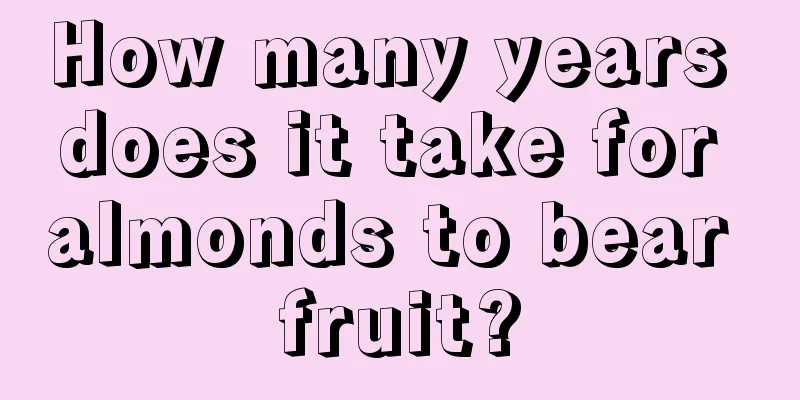How many years does it take for almonds to bear fruit?

|
Almond , also known as almond, is a nut native to Central Asia and the Mediterranean region. It is rich in protein, fat, vitamins and minerals, and has many benefits to human health. The market demand for almonds is huge, and growing almonds is also a profitable agricultural project. So how many years does it take for almonds to bear fruit? Let’s take a look below. 1. How many years does it take for almonds to bear fruit? Almond trees usually bear fruit in the third year, enter the high-yield period in the fourth year, and reach maximum yield in the sixth year. Specifically, almond trees will bear fruit sporadically in the second year after planting, and can produce a certain yield in the third year, with a yield of about 600-800 kilograms per mu. By the fifth or sixth year, almond trees will enter their high-yield period, with the yield per acre reaching 4,000 to 5,000 kilograms. The growth cycle and yield of almond trees are affected by many factors, including soil conditions, climatic conditions and planting management techniques. To ensure the healthy growth and high yield of almond trees, proper soil improvement, rational fertilization and pest and disease control are recommended. In addition, the planting area of almond trees is also very important. It is suitable for planting in warm and dry climate conditions, such as Xinjiang and other places. 2. Almond Planting Methods 1. Site selection and land preparation The garden site should be selected on flat terrain, with groundwater level below two meters, good drainage and strong air permeability in sandy loam. Before planting, dig trenches and prepare the land. The trenches should be 1-1.5 meters wide and 0.3-0.5 meters deep. 2. Planting method Planting is done in autumn, after the leaves fall and before the soil freezes. Planting is done in spring, after the soil thaws, before and during budding. Plant 28-45 seedlings per mu, use the trench planting method, dig large holes with specifications of 0.8m×0.8m×0.8m, apply 20-30 kg of decomposed organic fertilizer to each hole, tamp it down, fill with 20-30 cm of topsoil and then plant. After planting, tamp it down and water it. 3. Fertilization management Apply base fertilizer from September to October, mainly organic fertilizers such as decomposed sheep manure, chicken manure, oil residue, etc., and add appropriate amounts of nitrogen, phosphorus and potassium compound fertilizers . The ratio of nitrogen, phosphorus and potassium is 1:0.7:1. Before budding, apply 20 kg of quick-acting nitrogen fertilizer per mu. During the fruit expansion period from May to June, apply phosphorus-potassium compound fertilizer twice, 15-20 kg per mu each time. During the fruit development period from May to July, spray 0.3% urea, 0.3-0.5% potassium dihydrogen phosphate, 0.5% ferrous sulfate and other liquid fertilizers 2-3 times every 15 days. 4. Watering management Almond planting should be irrigated 3-4 times a year, once before budding, twice during the fruit expansion period, and once after fruit harvesting until leaf fall. Watering is prohibited during the flowering period, and water should be controlled in time in early August. 5. Timely pruning Pruning is an important part of almond maintenance. Pruning can adjust the tree shape, promote ventilation and light transmission, and reduce the occurrence of diseases and pests. Pruning is generally divided into spring pruning and summer pruning. 6. Tree management When the trees grow to 1-1.5 meters, they should be transplanted and fixed on supports to prevent them from falling over. When the trees are in bloom, pollination needs to be carried out. Artificial pollination or the introduction of pollinating insects can be used to increase the pollination rate and fruit set rate. 7. Pick at the right time When the trees bear fruit, be careful to pick them. Generally, you can pick them 10-15 days before the fruit is ripe, that is, when the skin turns yellow, to avoid them from overripening and falling. To sum up, almond is a nut that is rich in nutrition, has a large market demand, and has high planting efficiency. It is suitable for planting in warm and dry areas.
|
<<: What fertilizer should be applied during the passion fruit fruiting period?
>>: When is the best time to water garlic with frozen water?
Recommend
How long is the growth cycle of Hami melon?
Introduction to Hami Melon Growth Hami melon was ...
Can I plant a willow tree in front of my door?
Can I plant a willow tree in front of my door? Wi...
Where is the best place to plant coix seed?
Job's tears planting area Generally, Job'...
How to divide and plant Staghorn fern
Division time of Staghorn fern The best time to d...
Black seed pictures
Introduction to Nigella sativa Chinese name: Blac...
Cultivation methods and precautions of succulent money tree
The succulent money tree is not particularly easy...
How to drain water from potted plants and how to check whether water is accumulating in flower pots
1. How to drain water from potted plants 1. There...
Can succulents be exposed to rain? Can they be placed outdoors in the rain?
Succulents can tolerate moderate amounts of rain....
Cultivation method of rooted June snow
1. Soil When cultivating the root-lifted snow-whi...
Succulent leaves dried into skin? Congratulations, you have grown an old succulent plant!
Is it a good thing or a bad thing if succulent le...
How to change pots for Fire Festival
Fire Festival Repotting Preparation Look at this ...
How to eat bayberry
Bayberry Jam Prepare bayberry, tangerine peel, ap...
How much profit can 10 acres of apples make in a year (investment cost and profit of apple planting)
How much does it cost to plant 10 acres of apples...
Cultivation methods and maintenance matters of old Nandina domestica piles
Cultivation method of old Nandina domestica Old N...
How to trim the small gourd faucet to make it look good
Tips for pruning small gourd faucet Sesame oil: B...









